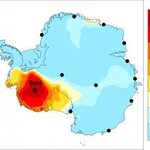Oceanography

A new paper that uses the
temperature record from Byrd Station, a scientific outpost in the center of the West Antarctic Ice Sheet (WAIS),
says that the western part of the ice sheet is experiencing nearly twice as much warming as previously thought.
The temperature record from Byrd Station shows an increase of 4.3 degrees Fahrenheit in average annual temperature since 1958, three times faster than the average temperature rise around the globe. If those older temperature readings are accurate, this temperature increase is nearly double what previous examinations have suggested.
"…

A large problem in making predictions about Antarctic melting is that we currently have insufficient knowledge about the ocean circulation near large glaciers in West Antarctica. This means that researchers cannot predict how water levels will change in the future with any large degree of certainty.
What is known is that the ice sheet in West Antarctica is melting faster than expected, and new observations published by oceanographers in Nature Geoscience may improve the ability to predict future changes in ice sheet mass.
A reduction of the ice sheets in Antarctica and…

Temperature rises are consistent with projections made in the IPCC's fourth assessment report (AR4) but satellite measurements show that sea levels are rising at a rate of 3.2 mm a year compared to the best estimate of 2 mm a year in the report, about 60 percent faster, says a new report.
They used an analysis of global temperatures and sea-level data over the past two decades, comparing them both to projections made in the IPCC's third and fourth assessment reports. Results were obtained by taking averages from the five available global land and ocean temperature series.
After…

Alaska's Columbia Glacier, an iconic glacier featured in the documentary "Chasing Ice" and one of the fastest moving glaciers in the world, will cease retreating around 2020, according to a study by the University of Colorado Boulder.
Their computer model predicts the retreat of the Columbia Glacier will stop when the glacier reaches a new stable position, about 15 miles upstream from the stable position it occupied prior to the 1980s.
The Columbia Glacier is a large (425 square miles), multi-branched glacier in south-central Alaska that flows mostly south out of the Chugach…

While New Yorkers (and others on the east US coast) prepare to deal with hurricane Sandy and the possible water surge resulting from the very strong winds and low pressure of the system, a similar situation is expected in Venice on Wednesday; unlike New Yorkers, Venetians are rather accustomed to the phenomenon - familiarly called "acqua alta" (high water) by residents. However, when the level of water is exceptionally high, normal protection systems to shops, offices, and ground floors of homes prove insufficient.
That is probably going to be the case in the evening of October 31st, when…

A global projection of the potential reduction in the maximum size of fish in a warmer and less-oxygenated ocean says that changes in ocean and climate systems could lead to smaller fish, according to fisheries experts at the University of British Columbia.
The researchers created a computer model to analyze more than 600 species of fish from oceans around the world and found that the maximum body weight they can reach could decline by 14-20 per cent between years 2000 and 2050, with the tropics being one of the most impacted regions, if warming and oxygen reduction models are accurate…

New Cracks In Pine Island Glacier
A huge crack which was discovered last October in Pine Island Glacier has propagated into a series of cracks during the Antarctic Winter. The recent satellite image below shows the new cracks. Newer images will no doubt show these cracks more clearly as the sun rises higher in the Antarctic skies. The animation below helps to demonstrate the great advance of the glacier front and the propagation of the cracks since February 2012.
Pine Island Glacier, September 11 2012.Source image:http://lance-modis.eosdis.nasa.gov/imagery/subsets/?subset=…

Once a year someone is claiming to be on the trail of Atlantis, a science-fiction city or nation or whatever in which super-smart people from the past were somehow wiped out and took a whole lot of cool technology with them.
Last year, it was at least interestingly supposed to be in Spain.
This year, it was maybe in the Baltic Sea - but if you are also searching for Atlantis make sure you use the right fuzzy language so you don't look silly when it turns out not to be aliens from the past. A "discovery" can be a "strange" and "mysterious" seafloor object and no one will object to that…

AUCKLAND, NZ – Twelve hours after liftoff from San Francisco airport, fifteen hours after my roommate dropped me off at the international terminal, I was hauling my luggage toward my connecting gate when the strap of my laptop bag abruptly tore off. Fortunately, somewhere in the back of my sleepy brain, I remembered that I’d packed a backup for the cheaply made bag, which hadn’t looked quite up to the task I’d asked of it. I re-packed books and electronics in a canvas tote, and ditched the ruined mess of plasticy fabric at the next trashcan.
It wasn’t until my next flight had…

So, I find that my students get a lot of their "news" and certainly their "entertainment" from YouTube, for better or worse. Today one student pointed me to this video from Russia Today: http://youtu.be/r-0gtkRB90w.
While it is pretty interesting- what a weird creature!- I was of course sceptical and wanted some more information. I also would rather read my information than get it from a video, but that might be a function of my age. So I found the "print" article: http://www.rt.com/news/abyss-alien-creature-jellyfish-004/. I was thinking it looked like a jellyfish myself, and MSNBC dug…